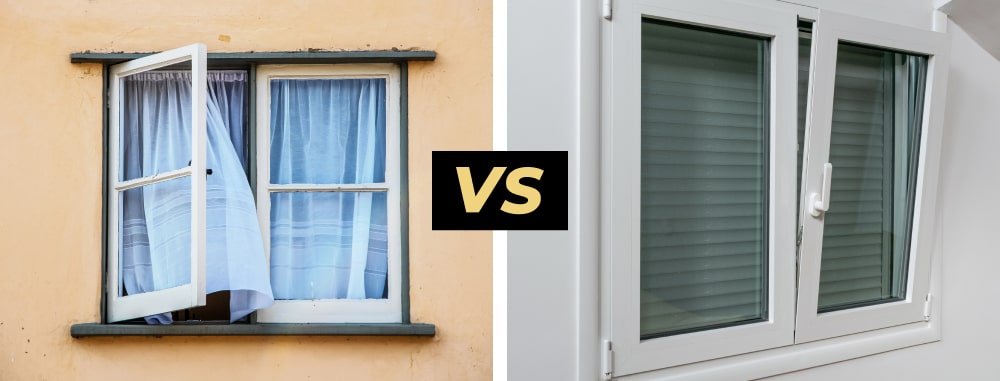
Casement vs Tilt and Turn Windows
The look, energy efficiency, and functioning of your house depend much on the windows you choose, so they are a major decision. For contemporary homes, two common choices are tilt & turn windows and casement windows. Although both kinds have special advantages, their designs, purposes, and costs differ. We shall contrast casement windows versus tilt and turn windows in this blog article, stressing their advantages and drawbacks to guide your choice.
Casement vs Tilt and Turn Windows: Key Takeaways
- Configuration: While tilt and turn windows have two methods to open, casement windows open outward like a door. Either tilting inward from the top or completely swinging inward like a door.
- Ventilation: When open, casement windows offer great ventilation; tilt and turn windows, on their dual-opening systems, give additional control over airflow.
- Value for money: Generally speaking, casement windows are less expensive than tilt and turn windows; nevertheless, materials and installation expenses will affect the price.
Casement Window Definition
Like a door, casement windows hinged at the side open outward. Usually running on a crank mechanism, they let homeowners readily adjust the width of the window. Casement windows give an unhindered view of the outside and optimal ventilation when open as they open totally. Big City Windows offers high-quality casement windows designed with modern materials and features to ensure durability and performance.
Tilt and Turn Window Definition
A flexible choice combining two ways of operation in one window are tilt and turn windows. The window tilts inward from the top in the tilt position to create ventilation without completely opening. Like a door, the turn position lets the window open inward on side hinges, therefore enabling stronger ventilation and simpler cleaning.
Though they are somewhat prevalent in Europe, tilt-and-turn windows are rare in North America. Big City Windows does not currently offer tilt-and-turn windows but provides double-hung tilt windows as an alternative for homeowners seeking flexible opening options.
Materials Used for Casement Windows
Usually at Big City Windows, casement windows are created from PVC, or polyvinyl chloride. Because PVC is reasonably priced, low-maintenance, and durable, it is a great material for windows. Apart from being energy-efficient, PVC is an excellent choice for every environment since it resists dampness and high temperatures.
Big City Windows also offers single-hung and double-hung tilt windows in PVC, but the company does not provide tilt and turn windows at this time.
Cost Differences of Casement vs Tilt and Turn Windows
When deciding which of casement and tilt and turn windows to choose, one must weigh long-term energy savings against the initial purchase price. Because of their basic design and broad availability, casement windows usually have more reasonable upfront cost. Conversely, tilt and turn windows are sometimes more costly, in part due to their more complicated mechanism and installation needs.
See Big City Windows' thorough information on the cost of casement and tilt windows to have a close-up view of window replacement costs. Although casement windows are usually the more affordable option, some homeowners may find the extra utility of tilt and turn windows justified by their higher price.
Casement Window Pros
- Great Ventilation: When opened, casement windows enable complete ventilation. They may capture side winds and guide airflow into your house as they open outward totally.
- Energy Efficiency: Closed casement windows provide great insulation and energy efficiency as the window sash closely pushes against the frame, therefore helping to save heating and cooling expenses.
- Unobstructed Views: Casement windows are perfect for places where you wish to optimize the view as they provide a clear, unhindered perspective of the outside without a central bar or divide.
Casement Window Cons
- Restricted Room for Opening: Casement windows open outward, so they need room outside, which could be a constraint in places where sidewalks or trees or other external objects are near the home. For homes with lots of outside space, this is usually not a problem though.
Tilt and Turn Window Pros
- Versatile Opening Options: The tilt and turn mechanism provides two methods to open the window, thereby allowing homeowners choice in how they ventilate their area. For smaller increments of ventilation, the tilt position is ideal; the turn position lets more airflow.
- Easy Cleaning: Second-story windows or regions that are difficult to access would find tilt and turn windows open inward excellent for cleaning from within the house.
- Security: Compared to windows that open totally outward, the tilt position enables airflow while leaving the window partially closed, thereby adding more sense of security.
While Big City Windows does not offer tilt and turn windows, their double-hung tilt windows provide similar functionality, offering multiple ways to open the window for both ventilation and easy cleaning.
Tilt and Turn Window Cons
- Slightly Pricey: Usually more costly than casement windows, tilt and turn windows are so because of their more complicated design and operation. For some households, though, the greater investment might be justified given the enhanced convenience and utility. For those seeking a more reasonably priced solution, casement windows offer excellent performance at a lower price point.
Casement vs Tilt and Turn Windows: Summary
Your priorities—that of money, ventilation demands, and simplicity of use—will ultimately determine whether you choose casement windows or tilt and turn windows. Looking for a reasonably priced, energy-efficient window with outstanding ventilation and unhindered views, casement windows are a terrific choice for homes. Conversely, tilt and-turn windows are a flexible option for houses where simple cleaning and security are vital as they open more easily.
Although both window designs have advantages and disadvantages, you may choose the ideal one for your house by weighing the main points of difference described above. Your decision should reflect the particular requirements of your house and your own tastes whether you want the simplicity and cost of casement windows or the multifarious use of tilt and turn windows.






